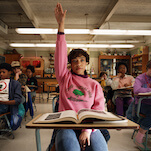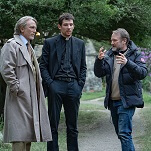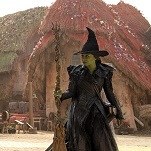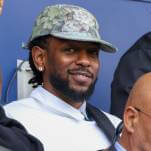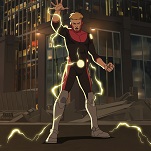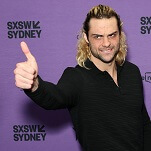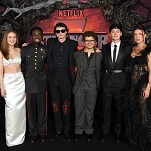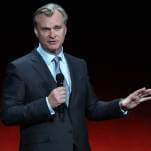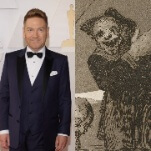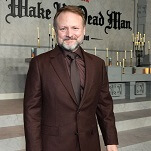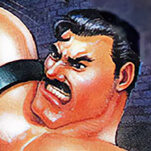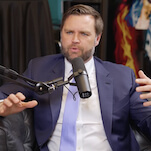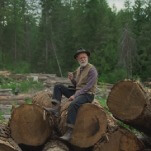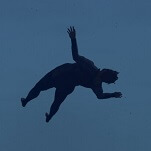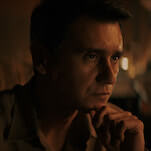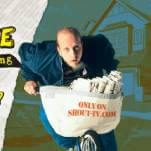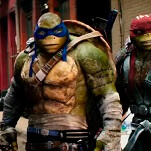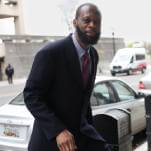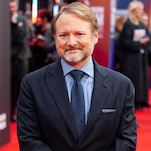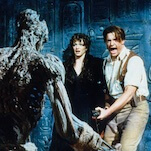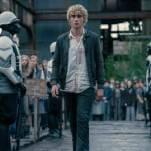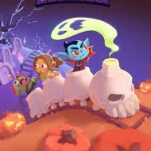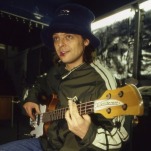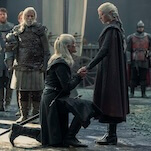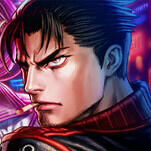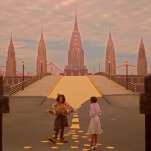Each week, Big Issues focuses on a newly released comic-book issue of significance. This week, it’s Prophet #39. Written by Brandon Graham (King City, Multiple Warheads) and drawn by Graham, Giannis Milonogiannis, Joseph Bergin III, Matt Sheean, Malachi Ward, James Stokoe, Aaron Conley, Jerry Lando, Ron Wimberly, and Simon Roy, this issue shows how the distinct perspectives of indie artists can bring immense depth to a superhero story. (Warning: spoilers ahead.)
It’s safe to say that Prophet proved to be the strongest of the Extreme Comics revivals from last year, with the concluded Glory coming in at a distant second. The further these comics strayed from their source material, the better they were, with Youngblood, Supreme, and Bloodstrike fully embracing their ’90s heritage to tell stories that read like they were 20 years old. The 1990s are millennia away in Brandon Graham’s Prophet, one of the most forward-thinking superhero comics on the stands. To call it a superhero comic is a stretch, but the fact that Graham has managed to turn a derivative Rob Liefeld property into an imaginative, sprawling sci-fi epic makes his work even more impressive.
Graham has teamed with an astounding lineup of alternative comic artists to realize his vision, and the use of different creators has helped distinguish Prophet from other books and keeps the title visually exciting and surprising. Prophet #39 takes the multiple-artist conceit to another level as Graham partners with nine alternative cartoonists to detail the history of the series’ robotic supporting player Diehard, spanning the time from age 10 to 10,241 for a deeply personal narrative that is massive in scope. Each cartoonist captures a certain period in Diehard’s life, whether it’s a single conversation at age 137 (Matt Sheean and Malachi Ward) or 3,000 years of exploration and meditation (Aaron Conley).
The distinct visual styles give each sequence its own atmosphere and tone, but Graham’s breakdowns unify the various creators by maintaining consistency in the panel layouts. This issue includes an amazing bonus feature in the form of Graham’s script, a collection of rough page sketches with minimal text and various reference images ranging from old Liefeld art to landscape photos. It can be very difficult to differentiate between the contributions of writers and artists in this highly collaborative medium (Kieron Gillen has suggested comic-book teams always be referred to as such, rather than individuals), and in the case of Prophet #39’s script, it’s clear just how much control Graham has over this title’s visuals. It also reveals how much flavor the final artists bring to the table, but the base ingredient in Prophet is Brandon Graham.
Nearly two years after its return, Prophet remains one of the best ongoing comic books, and while recent issues have begun to emphasize the overarching narrative regarding the rebirth of the Earth Empire, #39 returns to the standalone strangeness of the first chapters. The title page calls back to the opening sequence of #21—Graham’s first issue—using the same chunky lettering, but Diehard’s name replaces Prophet’s over an image of rocky terrain. (Turning the P in Prophet upside down for a lower-case d in Diehard is a particularly nice touch.) Whereas #21 opened with a sun-soaked desert landscape, #39 shows the cold, drab surface of Earth’s moon, suggesting a much more somber tale than that first barbaric adventure. There’s no lack of spectacular action thanks to James Stokoe’s ornately detailed, totally badass sequence of 877-year-old Diehard fighting in the 2nd Bolo War, but this issue is largely an introspective look at a man-turned-machine trying to find purpose in a life with no end.
The issue begins with Giannis Milonogiannis drawing a calm two-panel sequence of present-day Diehard playing an instrument in the sterile, white interior of the starship Insula Tergum. That melody takes Diehard into his past, a transition accomplished via Joseph Bergin III’s colors as he takes on full art duties for the only page featuring Diehard as wholly human. The music notes emanating from Diehard’s instrument are colored with shades of red and orange, the same hues emphasized on Bergin’s page. Graham covers 21 years with Bergin, separating Diehard at ages 10 and 31 with a series of cryptic images that the reader can interpret in different ways:
Bergin’s art is lush and expressive, making for a striking transition into the stark simplicity of Sheean and Ward’s four-page sequence revealing the final fate of Diehard’s superhero team Youngblood 100 years later. Snapshots of the deaths of former teammates show brief glimpses of the events, from the drops of wine pouring out of a glass to a giant downed hand clutching full-sized vehicles in its palm, asking the reader to fill in the rest of the off-panel information. As Diehard chats with teammate Badrock about their futures, Shaft debuts a new iteration of the team called Youngstar, and the lack of the flair in the art signifies the end of this extravagant time in the lives of these heroes. Sheean and Ward draw a Jeff Terrell that is far too old to be leading a superhero team, and it’s fitting that the segment ends with Terrell flat lining at the healthy age of 111.
Diehard and Badrock split ways, but their paths cross 750 years later when Diehard discovers that his old friend has become the leader of the Peace-Of-Stone Soldiers, who are fighting to stop the constant fighting. This discovery puts Diehard on a less violent path for the remainder of his existence, and that lifestyle shift is captured in the tone of the artwork. Diehard goes from the laser-shooting, chainsword-swiping central hero of an explosive two-page Stokoe spread to the six-legged father of two alien children in Jerry Lando’s pastoral sequence, a change that is broken down over the course of Conley’s page covering more than 3,000 years.
Conley’s section is notable for introducing Diehard’s present-day mirror helmet, a costume change that represents his ongoing identity crisis. After crash-landing on the planet Kyklos, Diehard sees a plant much like the huge tree from his childhood; the image is reflected on his helmet, revealing his desire to be like that tree without having him say a word. He sits cross-legged and meditates for over 2,000 years, rocks calcifying around his body as he becomes one with the alien world. That peace can’t last, though, and an alien fighter awakens Diehard, becoming his best friend when the robot joins the Mog tribe. That all happens over the course of six panels and tells a more poignant story than a lot of full-length comics.
Lando’s scene is the only time Diehard is under a blue sky, and there’s optimism in this bright new setting for the hero. There’s nothing in the dialogue to suggest that Diehard is happier than usual with his situation, but the fact that he’s significantly altered his shape is a smart way of visually depicting the character’s comfort in this environment. He could be content on this world forever, but eventually war engulfs Kyklos and he has to move on. Ronald Wimberly has the smallest contribution to this issue, drawing one panel on a page he shares with Graham’s artwork (and a Liefeld cameo). Wimberly will be drawing another Diehard-centric issue with Prophet #41 in two months, so it’s very possible that his panel will be expanded on down the line. It’s fitting that Graham would draw Diehard’s first meeting with Old Man Prophet and his crew, as he’s the man responsible for bringing these characters together in a captivating narrative.
The issue ends with five pages drawn and co-written by Graham’s initial Prophet collaborator Simon Roy, bridging the gap between past and present as the story catches up to Diehard’s status quo at the start of this run. Roy’s artwork is remarkably immersive thanks to the depth of his framing, pulling the reader in by making full use of the foreground, middle-ground, and background. The shot of wreckage floating in space shows the debris up front, a planet in the middle, and a sun in the background. The following image of Diehard, Hiyonhoiagn, and Jaxson watching ships take off on the planet’s surface shows a cruiser launching in the foreground, the three heroes in the middle-ground, and even more ships taking off behind the mountains in the background. These are very cinematic shots, but Roy applies the same principles to create visuals a film can’t replicate.
When Old Man Prophet throws down his Crown Shield, the moment is framed as three shots of Prophet layered on top of each other, a static image that achieves the same effect of a camera zooming in, but with added visual flourish. Bergin’s colors reflect the subject matter of each line—sunny yellow when Prophet talks about peace, blue when he talks about sleep, red when he predicts the inevitable return of the Earth Empire—and Prophet’s cape becomes a design element that adds a sense of motion in the middle of the panel.
Framing and color are also what make this issue’s back-up exceptional, with Paul Bohm telling a haunting story through five silent full-page images that zoom out from a jet plane crash. Each new page reveals more horrors committed in a mysterious desert city, forcing the reader to create narratives for images like a bloody woman walking out of a shack with a dead bear and man on the front yard or a person in a containment suit burning bodies in a trench. It’s a prime example of how coloring creates rhythm on the page, and the bursts of color are accent notes that keep the eye moving between bright spots as a sequence begins to form.
The back-up is a fantastic complement to the main story, and there aren’t many comics that offer this much artistic bang for the buck. Image took a chance giving Brandon Graham control over Prophet, but the unique point of view he cultivated with his alternative comics work has made the title a must-read every month. Prophet #39 is essentially a jam session between Graham and his cartoonist friends, but it’s also the perfect book for anyone looking for something truly different from a superhero title.

